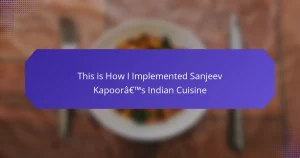Key takeaways
- Fusion dishes blend diverse culinary traditions, encouraging creativity and experimentation with ingredients and techniques.
- Cooking challenges enhance skills and foster community among home cooks, promoting sharing and collaboration.
- Successful fusion cooking involves balancing flavors, experimenting with textures, and knowing your ingredients for authentic combinations.
- Unique fusion recipes can reflect personal stories and experiences, adding depth and significance to the dishes created.

Overview of Fusion Dishes
Fusion dishes are a delightful blend of culinary traditions, creating an exciting marriage of flavors and techniques. I remember the first time I tried a dish that combined Korean and Mexican cuisines—I was amazed at how kimchi could complement the spiciness of tacos. It opened my eyes to the limitless possibilities when cultures and cooking styles intersect.
What sets fusion cuisine apart is its ability to challenge our preconceived notions of food. It encourages creativity and experimentation, pushing home cooks to step outside their comfort zones. Here are some characteristics that define fusion dishes:
- Diverse Ingredients: Incorporating elements from different culinary backgrounds.
- Innovative Techniques: Blending cooking methods to create unique textures and flavors.
- Cultural Storytelling: Each fusion dish often tells a story, reflecting the chef’s heritage and experiences.
- Visual Appeal: Typically colorful and beautifully presented, captivating the eyes as well as the palate.
- Adventure in Flavor: A chance to explore and taste the unexpected blends of spices, herbs, and sauces.
It’s these characteristics that make fusion dishes not only a treat for the taste buds but also a source of inspiration for every home cook eager to explore their creativity.

Importance of Cooking Challenges
Cooking challenges can transform the way we approach food. They encourage creativity, pushing us to think outside the box. I remember joining a cooking challenge that forced me to incorporate unexpected ingredients, igniting a passion for experimentation in my kitchen.
These challenges not only enhance our skills but also foster a sense of community. Sharing our unique creations, inspired by chefs like David Chang, allows us to connect over our culinary journeys. It’s thrilling to see how one dish can be interpreted in countless ways, each truly reflecting the cook’s personality.
Here’s a comparison table highlighting the key aspects of cooking challenges:
| Aspect | Cooking Challenges |
|---|---|
| Fosters Creativity | Pushes cooks to try new combinations and techniques. |
| Builds Community | Encourages sharing and collaboration among home cooks. |
| Enhances Skills | Provides experience in navigating different cuisines. |

Ingredients for Fusion Recipes
When it comes to fusion recipes, the ingredient selection is crucial. I often find myself wandering through my local market, looking for that perfect combination of familiar and unexpected flavors. For instance, combining traditional spices like cumin with ingredients from Asian cuisine such as soy sauce can elevate a simple dish to something extraordinary.
I’ve learned that the best fusion dishes often start with a strong foundation of fresh ingredients. Think about using vibrant vegetables that offer both texture and color, like bell peppers paired with pickled daikon. Have you ever experimented with something as simple as adding pomegranate seeds to a savory dish? The pop of sweetness can completely change the flavor profile, creating a dynamic experience.
Don’t shy away from daring combinations. I once concocted a pasta dish that featured pesto infused with miso—blending Italian and Japanese elements. The result was a creamy, umami-rich sauce that left my guests asking for the recipe. If you approach your pantry with an open mind, you’ll discover countless possibilities that can yield truly unique fusion recipes.

Techniques for Successful Fusion Cooking
When I think about fusion cooking, particularly in the context of David Chang’s unique dishes, several techniques stand out. One that I find incredibly effective is balancing flavors. This means understanding how different cuisines complement each other while respecting their distinct identities. I remember trying a kimchi pizza for the first time – the spicy tang of kimchi paired with melty cheese created an explosion of flavors that I had never experienced before.
Another technique is experimenting with textures. Incorporating crunchy elements into softer dishes can elevate the dining experience. I once attended a cooking challenge where we created tacos with crispy rice instead of tortillas. This not only added an unexpected crunch but also showcased how blending textures can redefine a classic dish.
Lastly, I believe that knowing your ingredients is crucial for successful fusion cooking. Selectively using authentic ingredients from each cuisine forms a foundation that respects their origins while allowing for creative freedom. I think back to a recipe where we used miso in an Italian risotto – it brought depth to the dish that I still reminisce about.
| Technique | Description |
|---|---|
| Balancing Flavors | Understanding and harmonizing the flavors of different cuisines. |
| Experimenting with Textures | Combining crunchy elements with softer dishes to enhance the overall experience. |
| Knowing Your Ingredients | Using authentic ingredients allows for creativity while respecting culinary traditions. |

My Experience with David Chang’s Dishes
My experience with David Chang’s dishes has been nothing short of transformative. I remember the first time I tried his famous ramen; it was a revelation that opened my eyes to the complexities and richness of flavors. The combination of traditional and unconventional ingredients makes each bite an adventure, filling me with excitement and curiosity about what else is possible in the culinary world.
As I prepared some of his unique fusion recipes at home, I discovered that they’re surprisingly approachable. I loved experimenting with flavors that I normally wouldn’t have combined, like miso and butternut squash. Each dish felt like a creative challenge and left me feeling proud of my culinary progress.
Here’s a simple comparison of two of David Chang’s standout fusion dishes that really showcase his innovative approach:
| Dish | Flavor Profile |
|---|---|
| Momofuku Ramen | Rich, savory with umami depth |
| Short Rib Tacos | Tender, spicy with a hint of sweetness |

Favorite Amateur Fusion Dishes
When it comes to fusion dishes, I often find that amateur cooks bring their unique flair into the mix. One of my favorites is the Korean BBQ taco, where the bold, smoky flavors of marinated beef dance with fresh salsa and corn tortillas. I remember the first time I tried making these; the combination of spicy kimchi and savory taco fillings felt like a revelation in my kitchen.
Another standout dish I’ve enjoyed is the sushi burrito, which marries the elegance of sushi with the heartiness of a traditional burrito. Chopping up fresh vegetables, selecting a variety of fish, and wrapping it all up in seaweed created a vibrant explosion of flavor. It was a joy to share with friends, and we found ourselves inventing our own variations, proving that creativity knows no bounds in fusion cooking.
Here’s a simple comparison of the amateur fusion dishes I’ve come to love:
| Dish | Main Ingredients |
|---|---|
| Korean BBQ Tacos | Marinated beef, kimchi, corn tortillas |
| Sushi Burrito | Fish, vegetables, seaweed |

Tips for Creating Unique Fusion Recipes
Creating unique fusion recipes can be incredibly rewarding, and I’ve learned a few tricks along the way. Firstly, think about complementary flavors from diverse cuisines. For instance, combining the sweetness of Thai coconut milk with the richness of Italian risotto can create an exquisite dish that surprises the palate. Have you ever blended two totally different cuisines? It’s exciting to discover how they can enhance each other.
Another tip is to play with cooking techniques. I remember a time I tried grilling fruit for a savory salad; the caramelized edges paired beautifully with a zesty vinaigrette. This simple twist transformed an ordinary dish into something irresistible. Why not experiment with your favorite ingredients and techniques? You just might stumble upon a combination that sparks joy.
Lastly, don’t hesitate to tell your story through your dishes. Every ingredient can reflect your unique culinary journey. For example, I once created a taco using my grandmother’s traditional beef stew recipe, wrapping it with a spiced flatbread inspired by Middle Eastern flavors. Each bite was a fusion of family heritage and contemporary cuisine, creating a dish that resonated deeply with me. How do your personal experiences shape the foods you create? Embracing that narrative can lead to amazing new recipes.


